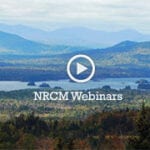Like many Mainers before me, I first felt the stirrings of an environmental consciousness somewhere between the Roaring Brook parking lot and Chimney Pond. It was a gift to grow up in Maine, where it is easy to live in proximity to natural beauty, and where I often felt that my daily life was well attuned to the natural world around me. This year, the pandemic brought me back, an unexpected return that included its own share of gifts and was enriched by a fall with the Natural Resources Council of Maine.
We’ve all spent more time at home this year. For me, it’s been a quieter year, more monotonous and stripped of human interaction than any I’ve experienced. It’s also been an opportunity to rediscover my home. In the past months, I’ve learned the patterns of the deer who graze through the woods behind my house; I’ve hiked, paddled, and camped on public lands across coastal and central Maine, in one instance finding myself uncomfortably close to a bull moose in the rut; and I’ve knit myself back into the familiar fabric of my hometown, which stretches across a ridge west of Penobscot Bay.

Enjoying the view from Cadillac Mountain at Acadia National Park (Courtesy Katie Moody)
Through my work with NRCM, I’ve gained a deeper understanding of how environmental advocacy functions, a knowledge that now extends not only to Maine’s lands, waters, energy sector, and environmental laws, but also comprises the network of citizens, organizations, and legislators who power the campaigns and policies to safeguard Maine’s environment. As I pulled together candidate profiles in the weeks surrounding the election, I grew familiar with a large portion of the Maine Legislature: names, faces, priorities, stance on environmental issues. While writing a series of stories for the newsletter, I spent a week making phone calls to residents in all corners of the state, listening as they shared the energy needs facing their respective regions. In a period of distance, these projects allowed me to feel connected to a broad swath of the state, to peel back the boundary lines of counties and legislative districts and see the people underneath.
Writer and conservationist Terry Tempest Williams speaks of a bedrock democracy. She writes, “Each of us belongs to a particular landscape…and in each of these places, home work is required, a participation in public life to make certain all is not destroyed under the banner of progress, expediency, or ignorance.”[1] Williams is calling for a participation in public life that stems from a commitment to protecting the places we love; she is calling for community engagement at the most fundamental level.
During my time at NRCM, I saw this brand of democracy at play. I watched meetings of the Maine Climate Council, where representatives from an array of backgrounds met to hash out a Climate Action Plan that transitions the state to renewable energy in a way that is equitable, timely, and comprehensive. When a mining company with a patchy plan threatened the region around Katahdin Woods and Waters National Monument, I saw a group of motivated citizens—sporting camp owners, anglers, tribal representatives, and concerned residents practiced at this type of campaign—rally to protect a place they care for, and uphold Maine’s Mining Law, the toughest in the country. This past election, I saw a handful of young candidates rise up to secure seats at the State House, in some cases beating well-established incumbents. This is bedrock democracy, and the next four years present a tremendous and crucial opportunity for environmental action at the national level, but just as importantly, for action in our own state, in our watersheds, our communities, and our own backyards.

Third Machias Lake (Katie Moody)
In my time with NRCM, I was perhaps most impressed by the fluency the staff displayed with environmental legislation, key players in the advocacy world, and the residents of many Maine towns. This is a knowledge amassed from years of relationship building and a deep engagement with the state of Maine. It is also the type of engagement required by the job. This fall showed me that it is this commitment to relationships—with people, processes, and place—that will continue to drive effective advocacy, even when we are once again able to travel farther from home.
[1] Terry Tempest Williams, RED (New York: Vintage Books, 2001), 19.










Leave a Reply